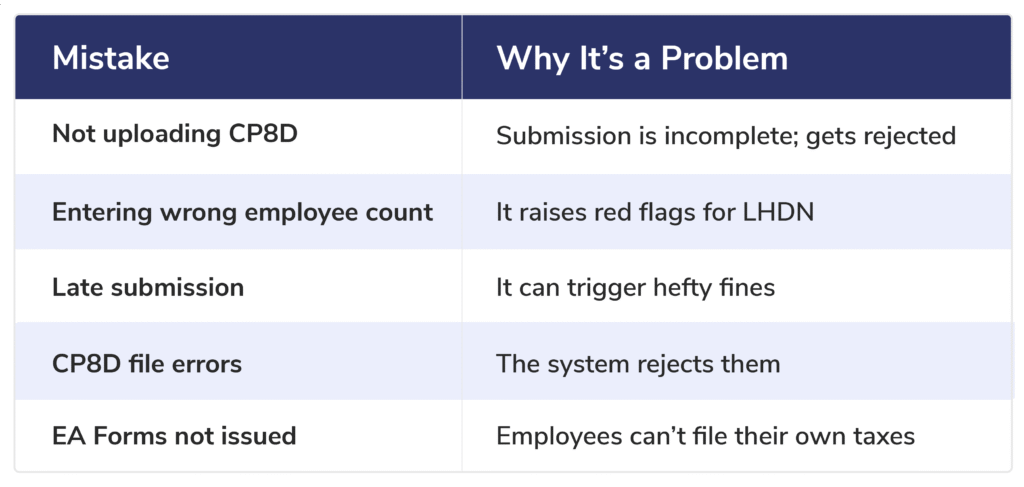Tax season doesn’t top anyone’s list of favourite times if you run a business. You’re busy managing payroll, following rules, and keeping your team on track. It’s no wonder something like “Form E” might slip your mind.
But here’s the catch: failing to submit your Form E doesn’t just waste your time—it can have a big impact on your wallet with hefty fines, delay your employee’s tax filings, and even put your business on the tax office’s radar for future audits.
Let’s take a step back. Before we get into due dates, penalties, or online portals, let’s tackle the main question:
What’s Form E In Malaysia All About?
Despite what many new employers think, Form E isn’t for employees—it’s for you, the employer.
It’s a mandatory tax form that every employer in Malaysia must turn in to the Inland Revenue Board (LHDN). This isn’t optional—even if you had no active staff during the year.
Here’s what Form E in Malaysia aims to accomplish:
- Verifies the number of employees on your payroll
- States that you’ve given out EA Forms to them
- Confirms you’ve deducted and reported employee income
Basically, Form E lets LHDN check that your company handles employee income reporting while following Malaysia’s tax laws.
When Should You Submit Form E In Malaysia?
The Form E submission deadline is typically 31 March every year, based on the Year of Assessment (YA).
For example, for YA 2024, the deadline fell on 31 March 2025.
That said, always refer to the official LHDN announcements or log in to the MyTax Portal to confirm the exact deadline for the current year. Submission is done exclusively online, as LHDN no longer accepts physical forms.
Staying updated with LHDN’s official channels helps you avoid missing cutoffs—especially if there are changes or extensions announced.
Even if you had just one employee, or your company didn’t operate, or even if you paid no wages—you still have to submit Form E. In these situations, you’ll file a “NIL return.”
What Happens If You Skip Filing It?
If you’re thinking, “It’s just paperwork,” think twice.
Here’s what missing the Form E deadline could mean for your company:

This isn’t just an empty threat. You’ll find it written in Section 120(1)(b) of Malaysia’s Income Tax Act 1967.
When LHDN flags your company, you can expect future reviews to become more rigorous.
Which Companies Must File Form E In Malaysia?
If you run a business in Malaysia and have at least one employee on your books—or did in the past—you need to submit this form.
These groups must file:
- SMEs and big companies
- Individual owners and partnerships
- NGOs, places of worship, and charitable groups
- Companies not operating but with employee records
In short, if you’ve ever signed up as an employer with LHDN, you’re on the hook for Form E.
Steps to Submit Form E in 2025
LHDN now has a online system, so you can file Form E through the MyTax Portal.
Here’s what you need to do:
Step 1: Log in to MyTax
Go to https://mytax.hasil.gov.my and enter your e-Daftar credentials to sign in. If you haven’t signed up yet, do it to avoid tech problems at the last minute.
Step 2: Go to e-Filing > e-Employer
After you log in, click on e-Filing, pick e-Employer, and select Form E for the current Year of Assessment.
Step 3: Fill in Employer Details
Enter your company’s tax file number, the total number of employees, and confirm whether you gave EA Forms to each employee before the EA Form deadline.
Step 4: Upload CP8D File
You have to upload a CP8D text file. This file should have all the salary and tax info of your employees.
Info-Tech Payroll users—here’s some good news! Our software creates CP8D files that meet LHDN standards. You won’t need to worry about getting the format right.
Step 5: Review, Sign & Submit
Check all details again, sign the form , and send it in before March 31, 2025.
What’s a CP8D File—and Why It Matters So Much?
CP8D isn’t just a document to support your submission—it’s a required part of the Form E process.
Here’s what you’ll find in it:
- Complete names and ID/passport numbers of staff members
- Total salaries, commissions, and bonuses paid
- EPF, SOCSO, and EIS payments
- Monthly PCB (tax) taken out
Turning in Form E without the CP8D file is like giving a report minus the real info—they’ll turn it down.
Usual Slip-ups That Might Cost You
Filling out Form E isn’t too hard—but there are typical traps if you’re doing it manually:

Want to avoid all this stress? Use payroll software that creates Form E, EA Forms, and CP8D in one place.
How Form E Links to EA Forms
Many business owners ask: “Aren’t EA Forms enough?”
Not quite!
Think about it this way:
- EA Form submission are for your employees to file their personal income tax.
- Form E is sent to LHDN showing you’ve met all your employer duties.
You can’t finish Form E until you’ve given out EA Forms to all employees. These two documents are interconnected and skipping either one can lead to legal problems.
To Sum Up
Turning in Form E might seem like just more paperwork, but it has a key part in keeping your company’s tax integrity and reputation.
Brushing it off doesn’t just result in penalties—it has an impact on staff confidence upcoming tax audits, and your company’s reputation.
So why take risks?
With Info-Tech’s automated payroll platform, you can manage Form E submissions the right way—without mistakes, by the deadline, and in full compliance.
Contact us for a free demo and we’ll make sure your tax filing is as hassle-free as possible!!
